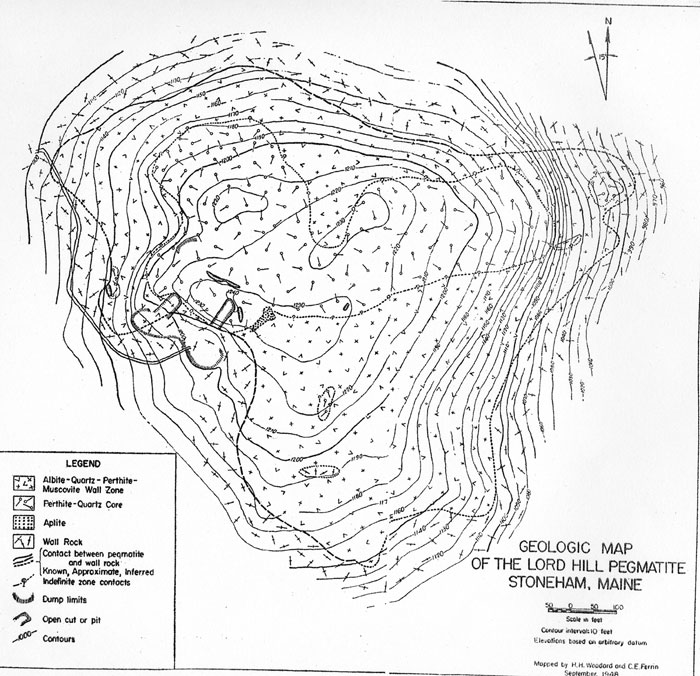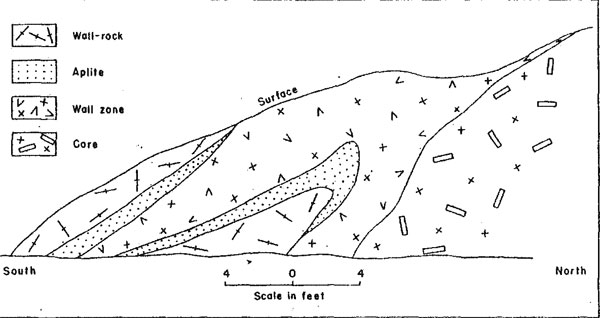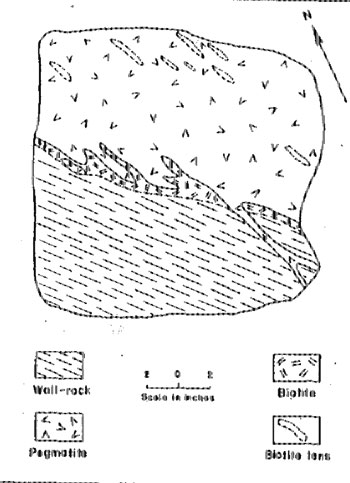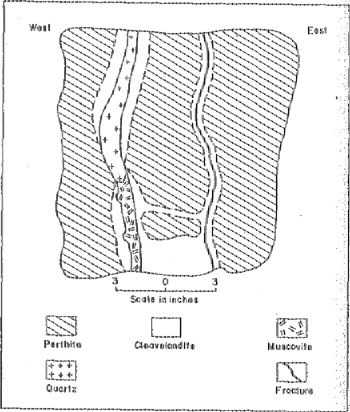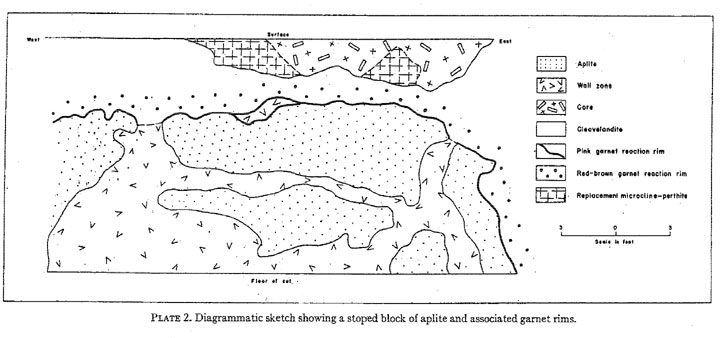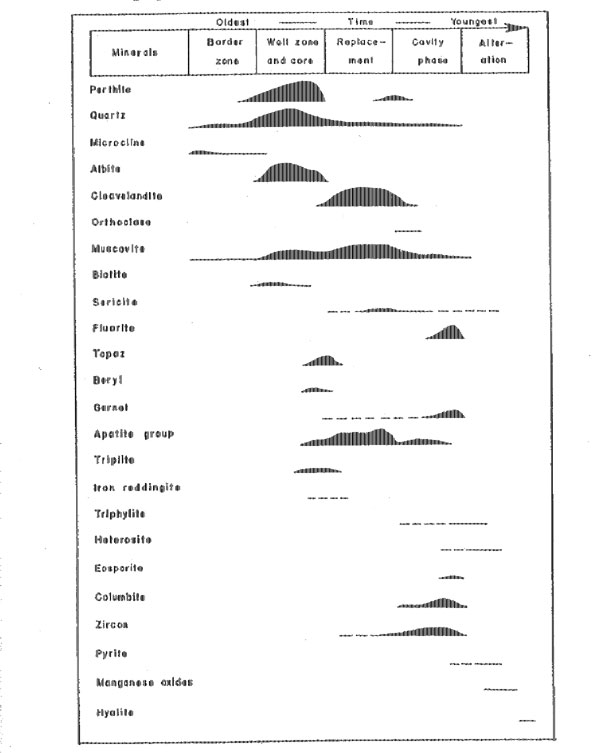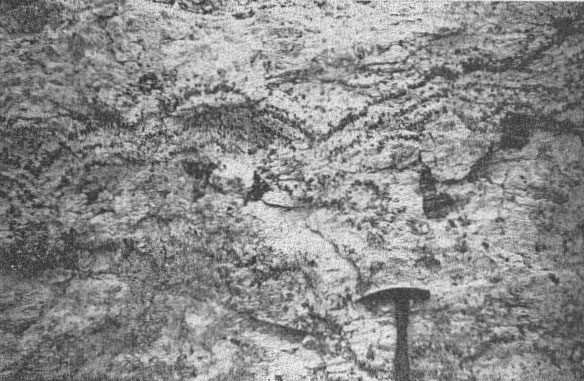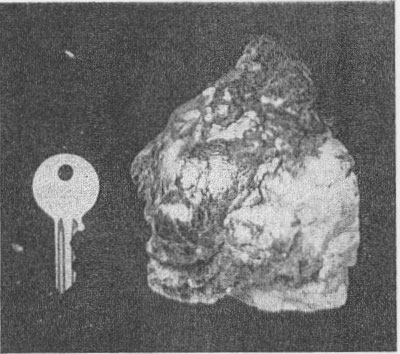| Home | AmMin | GMR | RiMG | Collectors Corner | Directory | Short Courses | |
|
|
|||||||

|
|
Volume 36, pages 869-883, 1951 THE GEOLOGY AND PARAGENESIS OF THE LORD HILL PEGMATITE, STONEHAM, MAINE H. H. WOODARD, University of Chicago, Chicago, Illinois ABSTRACT A field and laboratory study of the Lord Hill pegmatite, Stoneham, Maine, indicates that the pegmatite magma was mechanically injected into diorite country rock but that small amounts of quartz, muscovite, and microcline were introduced to the country rock producing a two-foot wide granitized halo around the pegmatite. Partial assimilation of the wall rock has contaminated and chemically altered at least the outermost zone of the pegmatite. The internal structure consists of zones, replacement bodies, and fracture and cavity fillings. Three zones are recognized: border zone (outermost), wall zone, and core (innermost). Replacement bodies of cleavelandite and perthite are restricted to the core. Fracture and cavity fillings are numerous both in replacement bodies and in unreplaced core. Twenty-four minerals have been identified, and their paragenetic relations determined. INTRODUCTION The Lord Hill pegmatite is one of a group of pegmatites of the Paris-Rumford district, in southwestern Maine. The general features of the Paris Rumford pegmatites have been described by Bastin (1911) and Sterrett (1923). The Lord Hill pegmatite lies at an elevation of 1,240 feet and caps the summit of Lord Hill, located in the north-central part of the north-west ninth of the Fryeburg, Maine, quadrangle. Intermittent mining of the Paris-Rumford pegmatites for gem stones, feldspar, and mica has been carried on for a period of about eighty years. No appreciable development of the Lord Hill pegmatite was carried out until the summer of 1947. At this time the Whitehall Company prospected the pegmatite for concentrations of block perthite. The total amount of feldspar removed during operations now lies in a stockpile on the main dump and does not exceed 5,000 tons. There appears to be no commercial concentration of book muscovite in the pegmatite. Field work consisted of making an extensive collection of specimens in 1947 while prospecting operations were still in progress. The pegmatite was mapped with plane table and telescopic alidade in September 1948 and the zoning of the pegmatite was studied at this time (Pl. 1). The writer is indebted to Dr. A. H. McNair of Dartmouth College for proposing the present study and for supervising the field work. Valuable criticism of the laboratory work, along with a critical review of the manuscript, was made by Dr. J. B. Lyons and Dr. R. E. Stoiber, both of Dartmouth College. The author also wishes to thank Mr. C. E. Ferrin for his expert assistance in the field.
STRUCTURAL FEATURES General statement. Exposures of pegmatite in the Paris-Rumford district are confined chiefly to a roughly circular area of approximately 1,400 square miles which lies on the east side of the White Mountains. The district is in rough country formed of many low mountains and hills, with many lakes and ponds in the intervening depressions. Many of these hills are capped with pegmatite. Dale (1923) has classified the country rocks as metamorphosed sediments and volcanics of early and middle Paleozoic age(?). These are cut by extensive bodies of granites and granodiorites of middle and late Paleozoic age(?). Bastin (1911) finds that most of the pegmatites of the district are confined to schistose country rocks. Some, however, are found within bodies of granite or other intrusions; the Lord Hill pegmatite, for example, occurs within a diorite body of local distribution. General structure of the pegmatite. The Lord Hill pegmatite is roughly circular in plan with the east-west outcrop diameter approximating 1,500 feet and the north-south outcrop diameter approximating 1,000 feet. Contact of the pegmatite with wall rock is poorly exposed except on the southwestern border near the two main cuts where it is concordant with a poorly-defined foliation in the country rock (Pl. 1). In the small southwestern cut, however, the contact is distinctly discordant. At all the exposed contacts the pegmatite appears to dip outward at angles of 60 degrees or more. The author is of the opinion that these dips are not representative of the actual form of the pegmatite. Recent studies show that internal structure is a more reliable criterion for determining attitude, owing to the irregular shape of many pegmatites. That the Lord Hill pegmatite is probably a relatively flat-lying sheet is evidenced by the sub-horizontal zoning as shown in the main cuts, and the topographic expression of the pegmatite as a whole. Cameron, Larrabee, et al. (in preparation) state that many of the pegmatites in the Paris-Rumford district are similarly flat-lying or gently dipping sheets. The wall rock has an ill-defined foliation produced by the partial alignment of biotite. This poor foliation strikes west-northwest and dips 50° SW to vertical. South and east of the main pegmatite numerous pegmatite stringers and quartz pods have been injected into the diorite. Most of these lenses are concordant with the wall-rock foliation, and approximate lit-par-lit injections; but some of the larger bodies, are discordant. In several cases these lenses and pods have their longest dimension approximately vertical. Erosion has only slightly unroofed the pegmatite. This fact is indicated by the large number of stoped blocks of wall rock and early-formed aplite which were engulfed and frozen into the pegmatite during solidification. Owing to the scale of the geologic map many of the smaller stoped blocks were not mapped.
Structural and Petrologic Relations of the Wall Rock with the Pegmatite. The country rock was originally an oligoclase (Ab75An25) diorite rich in biotite and containing minor amounts of apatite, hornblende, sphene (?), and quartz. However, most of the exposed wall rock now contains up to 30 per cent quartz as myrmekitic intergrowths with calcic plagioclase. The probable explanation of the myrmekite is that after the consolidation of the diorite, calcium was introduced into it and calcic plagioclase formed by replacement of oligoclase. The resulting SiO2 exsolved produced with plagioclase a myrmekite. Plagioclase in the myrmekitic portion of the diorite ranges from andesine (Ab60An40) to bytownite (Ab13An79). Small plagioclase crystals show a preferred crystallographic orientation of the quartz intergrowths throughout the whole grain, but large plagioclase crystals show several groupings of preferred orientation within single grain boundaries. The origin of the introduced calcium is unknown.
Where observed, the pegmatite country-rock contacts are sharp and well-defined (Fig. 1). Locally, biotite is segregated into clusters within the diorite close to the contact. There is no evidence of large-scale replacement of country rock. However, some small, partially assimilated wall-rock inclusions have a relict rim of biotite left at the contact, and relict lenses of biotite are contained in the adjoining pegmatite several inches from the contact. These biotite lenses resemble minute schlieren and are aligned at an angle to the strike of the contact. This seems to indicate there there was movement within the pegmatite during the assimilation of the inclusions (Fig. 2). Locally, the diorite wall rock and some of the diorite inclusions have been impregnated with quartz, microcline, and muscovite, and are therefore granitized. This granitized halo never has an observable width greater than two feet. In the field granitized diorite does not resemble the aplite-textured border zone in any way, but retains the typical diorite texture except that the poor foliation of the original diorite has been destroyed. However, thin section analysis of the aplite border zone indicates that small areas of this zone are composed in part of assimilated wall-rock materials.
The stoped blocks of aplite border zone have two rims of garnets associated with them. At the contact with pegmatite a one-sixteenth inch band, composed entirely of small, pink spessartite(?) crystals, has developed. These same garnets are abundant in the aplite inclusions, but are noticeably scarcer at the centers than nearer the contact. In many of the smaller inclusions they persist throughout the entire body. These garnets are intimately associated with late quartz, green apatite and cleavelandite and they were probably formed by late residual liquors which used the contact as a minor passageway. The second rim of garnets has developed one to two feet from the contact in the enveloping body of pegmatite (Pl. 2). These garnets are brownish-red in color, have a high luster, and are usually several inches in diameter. They formed around earlier crystals of milky yellow apatite. This second rim of garnets may represent the original outline of the stoped block of aplite. however, no proof for this possible explanation was observed. As has been noted above the effects of assimilation and granitization are small and local features. The large number of stoped blocks of aplite and of relatively unaltered, randomly oriented wall-rock inclusions, along with the sharp pegmatite-country rock contacts suggests that stoping or some other type of mechanical injection was much more effective than assimilation and replacement. Internal structure. Zones, replacement bodies, and fracture and cavity fillings may be recognized within the Lord Hill pegmatite. The accompanying geologic map shows only the main zones, the scale of the map making it impossible to plot the replacement bodies and fracture and cavity fillings (Pl. 1). In general the zones are composed chiefly of quartz, perthite, cleavelandite, albite, microcline, and muscovite with minor amounts of other minerals. Border Zone. The border zone is the outermost zone and for the most part is very thin, ranging from 2 to 8 inches in thickness. Mineral constituents vary from place to place owing to local contamination through partial assimilation of wall rock. Microcline, perthite, oligoclase (Ab72An28), biotite, and muscovite are the chief minerals and form a typical fine-grained, equigranular, aplitic-textured rock. The plagioclase shows features of possible genetic significance. In the border zone, a reverse zoning of oligoclase crystals to slightly more calcic exteriors is very evident. Associated with this reverse zoning are myrmekitic intergrowths of quartz and plagioclase. In some cases the intergrowths are confined to the more calcic borders of the oligoclase crystals, but in others, they persist throughout the grain. The reverse zoning of the plagioclase was possibly caused by crystallization from the pegmatite magma of more calcic plagioclase around preexisting crystals of myrmekitic oligoclase. One may advance the explanation that, on partial assimilation of wall rock by the pegmatite magma, the oligoclase persisted as crystal inclusions. The myrmekitic andesine to bytownite of the diorite was reacted upon by the pegmatite magma to produce oligoclase which retained the original myrmekitic quartz intergrowths. The liquor was locally enriched in calcium, and consequently a calcic border precipitated around the oligoclase inclusions. Equilibrium never was attained because of the relatively rapid cooling of the border zone. An alternative explanation to the above hypothesis is that the reverse zoning of the plagioclase in the border zone was caused by the same solutions which caused the myrmekitic intergrowths in the diorite wall rock. The calcium may have been derived from calcium-bearing wall rock minerals during assimilation by the pegmatite. However, this would necessitate a re-introduction of this calcium to the wall rock in order to produce the wall rock myrmekite. This seems unlikely. The difference in composition of the myrmekitic plagioclase in the border zone (Ab72An28) and the myrmekitic plagioclase in the wall rock (Ab60An40-Ab13An79) indicates that the calcium necessary to produce these two features was not derived from the same source, for had it been, both plagioclases would be of the same composition.
Crystal growth as shown in thin sections indicates that microcline, perthite, quartz, muscovite, and small amounts of micropegmatite crystallized at approximately the same time. Oligoclase (in part) and biotite are earlier in origin and, as previously stated, are believed to have been derived from the diorite wall rock. Wall Zone. The wall zone lies inside the border zone, and for the most part is considerably thicker. Width of outcrop ranges from 3 feet in the vicinity of the main cuts to more than 500 feet on the southeastern prong. Field observations show sharp contact relations between this zone and the border zone. Study of thin sections, however, reveal a one-half inch zone in which grain size grades from the aplite size of the border zone into the coarse-grained pegmatite wall zone. The grain size of the zone in general is evenly textured, with crystals up to 1½ inches in diameter. Locally, the grain size changes rapidly and ranges from a granitoid textured rock with grains up to one-fourth inch in diameter, to the normal grain size of the zone. Albite, quartz, perthite, and muscovite are the chief minerals, with small amounts of oligoclase, biotite, and spessartite (?) also present. The oligoclase (Ab72An28) occurs adjacent to the border zone-wall zone contact and has a more calcic exterior. The cause of this reverse zoning has been discussed in the preceding section on the border zone. Perthite content increases from the border zone inward, and the inner contact of the zone is drawn approximately at the place where perthite becomes the most abundant mineral (Pl. 1). Many aplite blocks and country rock blocks, ranging from 1 foot to 100 feet in greatest dimension, form inclusions in this zone. They were apparently stoped from the walls during intrusion. The apparent large size of some of the aplite blocks is difficult to explain when one considers the exposed width of the aplite border zone. It is possible that these few large blocks have a small, unobserved third dimension. Core. The core consists of four separate bodies which are not connected in surface exposures. As a whole the core forms the central portion of the pegmatite. Its nearest approach to the wall rock is along the southeastern hanging wall, where the two are only four feet-apart. On the southern prong it is separated from the wall rock by over 500 feet of wall-zone outcrop. The chief minerals of the core are perthite, quartz, muscovite, and cleavelandite, with minor amounts of albite, biotite, fluorite, spessartite(?), and topaz. Grain size ranges from 1½ inches in diameter to crystals 8 feet long by 4 feet wide. Interstitial, granitoid-textured quartz, albite and muscovite are abundant, and the smaller perthite crystals are graphically intergrown with quartz. Three concentrations of block perthite occur in the pegmatite. The largest of these is found close to the southern hanging wall where the two main cuts were opened. This portion of the core has been replaced to a large extent by cleavelandite and its associated minerals; almost one-half the volume now being cleavelandite. The second largest concentration of block perthite, and the one showing the largest perthite crystals, crops out on the northeastern prong of the pegmatite. This outcrop shows little or no cleavelandite, and only small quantities of muscovite are present. However, interstitial quartz with some albite is quite common. The third area of block perthite crops out in the small western-most open pit and has a low perthite content. The boundaries of these concentrations are indefinite and unknown. They probably grade imperceptibly into finer-grained core minerals, which in turn grade outward into wall zone. The core contains many inclusions of aplite. In one locality wall-zone pegmatite intrudes and cuts aplite. This block of wall-zone pegmatite and aplite was itself stoped, and is now preserved as a large inclusion in the core. The core displays crosscutting relations to both the aplite and the wall zone of the stoped block, and is, then, the last part of the original granitoid pegmatite to crystallize (Pl. 2). Replacement bodies and fracture and cavity fillings. Replacement bodies are common in the core, especially near the two main open cuts. They range from roughly radial bodies to irregular masses and are often controlled by pre-existing fractures. Small tabular replacements parallel to fracture walls are also common (Fig. 3). Cleavelandite is the chief mineral formed by replacement. However, perthite replacement bodies are also present, especially in the large westernmost cut where they are three to five feet in diameter. Both cleavelandite and perthite replace, corrode, and vein the original core minerals and are thus later in age. Associated with cleavelandite are many cavities or vugs, which contain the rarer mineral constituents. Most of these cavities are small and average between one and five inches in diameter. One vug which was opened during the 1947 operations measured approximately 5 X 7 X 10 feet. Fracture fillings of quartz and muscovite are numerous. They cut all earlier minerals and range in age from pre-albitization to the last stages of the cavity phase. DESCRIPTIVE MINERALOGY Perthite, quartz and albite make up 99 per cent of the pegmatite. Figure 4 diagrammatically represents the order of precipitation of the minerals in the pegmatite. Perthite. At least 95 per cent of the perthite in the pegmatite formed during the original crystallization. However, replacement bodies, dikes, and a few cavity fillings of perthite occur in the core, close to the wall zone-core contact. This perthite is especially abundant at the face of the large western open cut (Pl. 2). It is always a late mineral and in part replaces cleavelandite. The replacement bodies and cavity fillings are always dirty gray, whereas the dikes are white. The color difference is caused by many microscopic opaque inclusions, which are present in the dirty gray varieties and absent in the white dikes. The dikes range between one-fourth and three-fourths of an inch in width. They have parallel walls, and form almost perfect tabular bodies, which are, in fact, single crystals which retain the same crystallographic orientation throughout the entire observed length of the dikes. The dikes are apparently fillings of straight-walled fractures, but in some cases they terminate in cavities in replacement perthite. Euhedral crystals, commonly intergrown with fluorapatite, cap the dikes which terminate in cavities. In all cases the dikes cut sharply across the perthitic structure of the replacement perthite. This, plus the fact that some terminate in cavities in the replacement perthite, testify to the dikes later age.
Several small cavities in both replacement perthite and cleavelandite contained euhedral, dirty gray crystals of perthite. Quartz. Cavities developed in the cleavelandite often contain many euhedral quartz crystals. One large cavity contained several tons of quartz crystals, both of the smoky and milky variety. Orthoclase. The Lord Hill pegmatite, like most pegmatites, contains only minor amounts of orthoclase. Locally, in small cavities in replacement cleavelandite, euhedral, pink, lustrous, orthoclase crystals are developed. Many of the cavities were completely filled by these crystals. The time of crystallization is closely associated with the late replacements and dikes of perthite which were discussed above. Orthoclase refractive indices measured in sodium light are: α=1.518, ß=1.524, γ =1.527. No polysynthetic twinning could be observed optically. Muscovite. Large amounts of gray, green, or rum muscovite are associated with cleavelandite. The greatest percentage of this muscovite is of the curved or "ball peen" variety, and is localized as halos around the periphery of cleavelandite bodies (fig. 5). The external features of the ball peen variety are quite striking when observed in hand specimens. The muscovite crystals appear as though they had been struck innumerable times with a peening hammer; first by heavy blows producing major indentations, and then by lesser blows which superimpose minor indentations on the major curved surfaces. The term botryoidal probably best fits these external characteristics (Fig. 6). Shainin (1946) describes curved muscovite crystals from Branchville, Connecticut, and ascribes them to growth on curved surfaces of radial bodies of cleavelandite. There is no evidence for a similar mode of origin for the ball peen mica of the Lord Hill pegmatite. This mica is usually associated with quartz, and a large percentage shows an extremely fine, graphic intergrowth with this mineral. This association possibly indicates a replacement of the feldspar in graphic granite by muscovite, but there is no evidence for such replacement having taken place. Commonly, the mica appears contemporaneous with and in some specimens later than quartz and may in part replace it. Shear planes, developed in the muscovite roughly perpendicular to the cleavage, are common, and drag on both sides of the shear planes is locally developed. In thin section the mica always exhibits strong strain shadows. One specimen consists of a large book of green muscovite which grades from perfectly normal, flat folia on one side of the specimen into gray, ball peen folia on the other. This suggests that the ball peening has nothing to do with the quartz with which it is usually associated but rather is an alteration of preexisting, normal muscovite. The structure may be due to late volume increase because of the addition of materials to the preexisting muscovite. The shear planes and strain shadows which are developed, plus the fact that many curved specimens appear as an alteration product of earlier muscovite, lend support to this argument. If this is true, however, the added materials do not change the axial angle and refractive indices of the muscovite in any way, these optics being as follows: biaxial negative, 2V=45°; α=1.560, γ=1.598. Two types of muscovite are common as cavity fillings in cleavelandite. The first type is a yellow-green, talc-like muscovite that was deposited as radiating groups coating cavity walls. The other type is a cream colored variety which grows as small radiating groups in cavities. Sericite. Sericite, a fine-grained variety of muscovite, occurs rarely as fine-grained plumose masses in cleavelandite. These masses are up to 3 inches in diameter and range in color from pink to brown. A light pink variety of sericite occurs sparingly interlayered with sheaves of cleavelandite. Both varieties of sericite appear to have indices of refraction similar to that of muscovite. Fluorite. Fluorite, a major accessory mineral in the pegmatite, is restricted to cavities in cleavelandite. Exceptional crystals are developed in many of the cavities. The most common habit is a cube modified by octahedral faces, but perfect octahedrons are rarely developed. The modified cubes commonly reach one-half inch in diameter, whereas octahedrons are considerably smaller. There is a marked difference in color depending on the type of crystal. The modified cubes are zoned to an extremely dark purple exterior. This exterior zone terminates abruptly inward against a light purple zone, which in turn grades into a pink zone and then a colorless center. The pink zone may, or may not be present in a single crystal. The octahedral crystals in all observed specimens had no dark purple zone on their exterior but were either colorless, pink, or light purple with patches of darker purple present. Beryl. Three types of beryl are present in the pegmatite. All types are rare. The most abundant is a milky yellow variety which occurs with and encloses the phosphate triplite. Both of these minerals occur with original core minerals and probably crystallized during late core formation. It has the following optical and physical properties: uniaxial negative; ε=1.565, ω=1.572; basal cleavage. According to Winchell (1933, p. 213) the above indices indicate an alkali content of less than 0.5 per cent. A pale green variety of beryl is veined and corroded by muscovite and cleavelandite. Optical properties are as follows: uniaxial negative; ε=1.574, ω=1.580. These indices indicate an alkali content of 1.2 per cent. One fragment of a clear, blue-green aquamarine crystal was found on the dump. Indices of refraction are the same as those for the pale green variety. Topaz. Clear, pale green to colorless topaz is the second most abundant accessory mineral in the pegmatite. It occurs in highly fractured masses which are commonly several inches in diameter. In all cases it is corroded by cleavelandite or yellow-green muscovite. Optical properties of topaz: biaxial positive, 2V=65°; α=1.617, ß=1.620, γ=1.629; r>v distinct; perfect basal cleavage. Apatite. Several types of apatite are present in the pegmatite. They are described in order of decreasing abundance. A dark blue-green apatite is closely related in age to albitization, some being veined and corroded by cleavelandite and some showing mutual relations with cleavelandite. It occurs in irregular highly fractured masses up to several inches in diameter. Optical properties are as follows: 2V=15°; α=1.644, ß=1.648, γ=1.648; pleochroism slight, α=yellow-blue, γ=light blue; X>Z. The second type of apatite always occurs as euhedral crystals filling cavities in replacement bodies of perthite and cleavelandite or as intergrowths with late perthite dikes. Thus this type of apatite is post albitization, and contemporaneous with the perthite dikes. Several crystal habits are represented.
The most common crystal habit is elongate parallel to the c crystallographic
axis, and probably has the c{0001}, m{10
The second most common habit probably has the c{0001}, m{10
The third most common habit has a facial development which is very complex, and
probably the following faces are represented: c{0001} , m{10
The least common habit occurs in long prismatic crystals with only the c{0001},
m{10
Optical properties of all euhedral apatite: uniaxial negative; ε= 1.631; ω=
1.634. Cleavages: {0001} and {01 The third type of apatite present in the pegmatite is localized in cleavelandite, and has only been found as centers of the large garnet crystals which form a zone around aplite inclusions. The garnet veins and encloses the apatite center, and is distinctly later. The mineral is milky yellow in color, highly fractured, and has the following optical properties: uniaxial negative; ε=1.635, ω=1.639; perfect basal cleavage. Triplite. Triplite is common in the pegmatite. It is associated with, and included within milky yellow beryl, which crystallized concurrently with the quartz and feldspar of the core. The mineral is salmon-colored and commonly stained on the exterior by late manganese oxides. It has the following optical and physical properties: biaxial positive, 2V= 85° (estimated); r>v distinct; α=1.673, ß= 1.685, γ=1.698; one perfect and one poor cleavage. Iron reddingite. One specimen of iron reddingite was observed in the Lord Hill pegmatite. It occurred as a lustrous, dark red, highly fractured, circular mass 3 inches in diameter and 1 inch thick. Optical properties of iron reddingite: biaxial positive, 2V=80° (estimated); r>v distinct; α=1.669, ß=1.681, γ=1.697; pleochroism, α=colorless, ß=light brown; cleavage, one perfect - probably {100}. Heterosite(?). This mineral is associated with manganese oxide stain, and is a late alteration product. It is found very rarely as extremely thin, red-violet patches on yellow beryl and triplite crystals. All indices of refraction are above 1.788, and pleochroism is strong - carmine red to violet to greenish brown. Eosphorite. One cavity in cleavelandite yielded numerous small orthorhombic crystals of eosphorite up to 3 millimeters in length. It occurs as radiating groups growing upon a yellow drusy mineral, which was not identified. The crystal habit is long, prismatic, and tabular parallel to the a{100} face. The form is simple, with the a{100}, b{010}, and p{111} faces developed. The crystals are zoned from a colorless interior to a wine yellow exterior. The optical properties of the Lord Hill eosphorite differ somewhat from those given by Larsen and Berman (1934). The mineral is biaxial negative, 2V=62°; r>v distinct; α=1.643, ß=1.666, γ=1.672; optic orientation, Y=a, Z=c: pleochroism weak with γ=colorless and α= yellow-brown; one perfect cleavage parallel {100}. Columbite. Many small crystals of columbite are found in cavities and imbedded in cleavelandite bodies. Most of the crystals are thin, tabular and one-fourth inch or less in length, and have one of two probable sets of faces developed: (1) a{100}, b{010}, d{170}, m{110}, k{011}, a{131} and u{111}; (2) a{100}, b{010}, c{001}, m{110}, and e{201}. The specific gravity of this columbite was determined as 5.64. Thus an approximate Ta 3O5 content of 15 per cent is indicated (Palache, et al., 1946, p. 786).Zircon. Commonly small euhedral crystals of zircon are found embedded in either cleavelandite or gray muscovite. Occasionally it is associated with deep purple fluorite and colorless fluorapatite. Most crystals have a yellow-brown halo surrounding them, which is probably due to radioactive effects on the surrounding minerals. The mineral has two good cleavages at right angles. Unidentified mineral. A yellow platy mineral, which resembles autunite, forms a crust on fracture walls. It is one of the latest minerals in the pegmatite. Larsen and Berman (1934) list no minerals which have the optical properties determined for this specimen. Determinations are poor, however, because of the mineral's rarity. It is biaxial negative With 2V=40° (estimated); r>v strong; strong horizontal dispersion of the vibration directions; ultra-blue, abnormal interference colors; α=1.604, γ=1.610; at least three good cleavage directions. CONCLUSIONS ON PARAGENESIS The geologic and petrologic relations of the Lord Hill pegmatite have led to the conclusion that the pegmatite has slightly granitized its walls and at the same time has assimilated some material. Reference to Fig. 4, Plate. 1, and the preceding sections on the mineralogy and structure of this deposit suggest the following conclusions: (1) A residual magma rich in K, Na, Si and the rarer elements was mechanically injected into oligoclase diorite country rock. (2) This residual magma crystallized in a definite sequence. The first minerals crystallized were those rich in potash, soda, and silica. It is these minerals which chiefly comprise the border zone of the pegmatite. The wall zone and core, which were still mobile while the border zone was crystallizing, respectively then crystallized. When these two zones crystallized the order of crystallization was similar to that of an igneous melt. Albite is the most abundant mineral in the wall zone, and potassium feldspar is the chief mineral in the core. There was an enrichment in the rest magma of the minor amounts of rare elements. The development of the zones occurred in an essentially closed chemical system. (3) Na rich solutions reacted on favorable areas of the core replacing the original zone minerals with cleavelandite. These solutions may represent a new addition of material to the pegmatite (open system). (4) Hydrothermal solutions deposited phosphates and fluorides in cavities along with other rarer components. REFERENCES BASTIN, E. S. (1911), Geology of the pegmatites and associated rocks of Maine: U. S. Geol. Survey, Bull. 445. CAMERON, E. N., LARRABEE, D. M., McNAIR, A. H., PAGE, J. J., SHAININ, V. E., AND STEWART, G. W., New England mica deposits (in preparation). DALE, T. N. (1923), The commercial granites of New England: U. S. Geol. Survey, Bull. 738, 209. LARSEN, E. S., AND BERMAN, HARRY (1934), The microscopic determination of the nonopaque minerals: U. S. Geol. Survey, Bull. 848, 179. PALACHE, C., BERMAN, H., AND FRONDEL, C. (1948), Dana's System of Mineralogy: vol. 1, p. 786, New York, John Wiley and Sons. SHAININ, V. E. (1946), The Branchville, Connecticut, pegmatite: Am. Mineral., 31, 336 338. STERRETT, D. B. (1923), Mica deposits of the United States: U. S. Geol. Survey, Bull. 740, 94-100. WINCHELL, A. N. (1933), Elements of Optical Mineralogy, Part II. Description of minerals: New York, John Wiley and Sons. WRIGHT, F. E. (1911), The methods of petrographic-microscopic research: Carnegie Inst. Washington, Pub. 158, 147-200. Manuscript received June 1, 1951.
|
